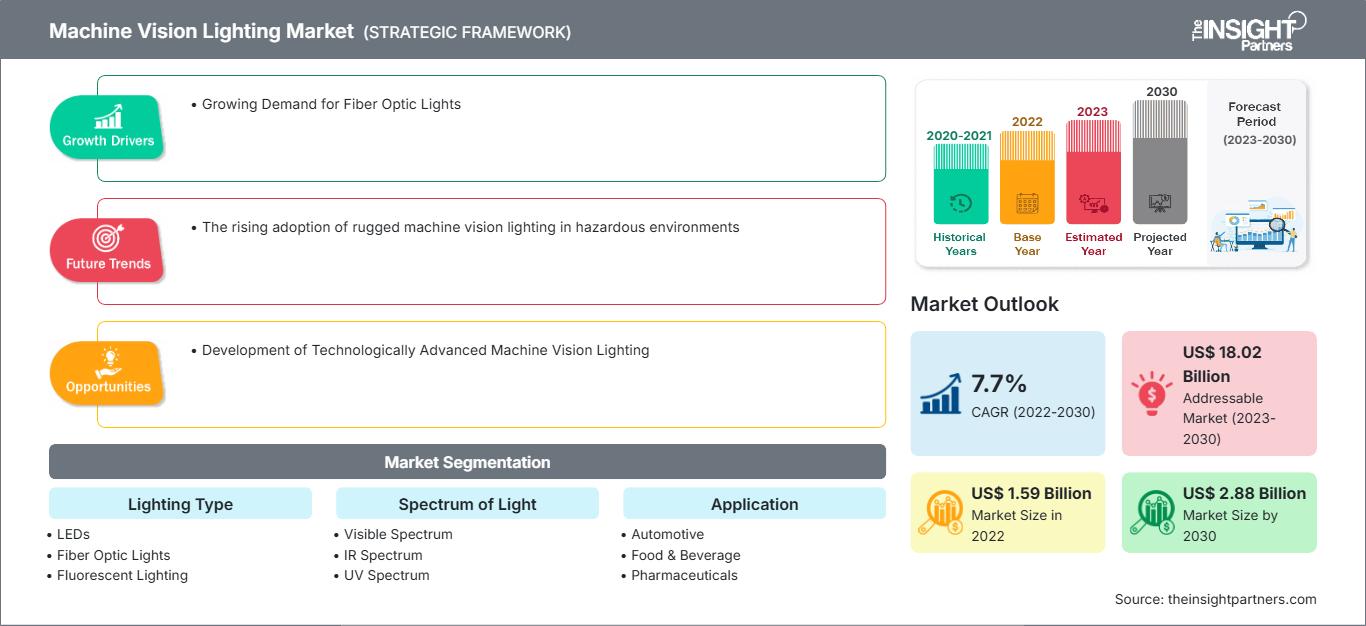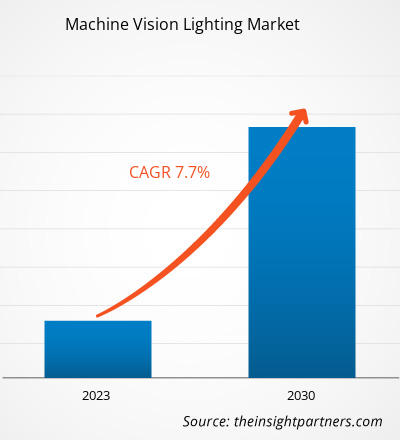机器视觉照明市场规模预计将从 2022 年的 15.9 亿美元增至 2030 年的 28.8 亿美元。预计该市场在 2022 年至 2030 年期间的复合年增长率为 7.7%。在危险环境中越来越多地采用坚固耐用的机器视觉照明可能仍将是市场的主要趋势。
机器视觉照明市场分析
对光纤灯不断增长的需求以及对提高制造过程中质量和生产率的日益增长的需求正在推动市场的发展。由于在危险环境中越来越多地采用机器视觉照明,预计该市场在预测期内将以显著的速度扩张。此外,技术先进的机器视觉照明的发展和制造业的不断扩张正在为市场创造有利可图的机会。
机器视觉照明市场概览
机器视觉照明是指在机器视觉领域应用特定的照明技术和设备。这项技术使机器能够捕捉并解读周围环境中的视觉信息。在机器视觉应用中,合适的照明对于提高图像质量和准确性至关重要。机器视觉照明旨在最大限度地提高机器视觉系统所检测或分析的物体或场景的照明。机器视觉照明提供的显著优势,例如色彩精准度、对比度、消除眩光、对比度和降低噪点等,正在推动市场的发展。
自定义此报告以满足您的要求
您将免费获得任何报告的定制,包括本报告的部分内容,或国家级分析、Excel 数据包,以及为初创企业和大学提供超值优惠和折扣
机器视觉照明市场: 战略洞察

-
获取本报告的主要市场趋势。这个免费样本将包括数据分析,从市场趋势到估计和预测。
机器视觉照明市场驱动力与机遇
光纤灯需求增长,利好市场
光纤照明可以最大限度地提高视野范围内的光均匀性,同时最大限度地减少灯输出的差异。考虑到广泛的应用,光纤照明非常适合,它能提供强烈、聚焦(或靶向)和均匀的光线。与滤光片结合使用时,光纤可以排除或增强波长,从而优化输出以控制对比度或避免发热。如果应用需要,光纤可以构建在极小的空间内工作。光可以通过小至 30 μm 的单根光纤传输。如果应用在高温环境中,光纤可以与远程光源配合使用。标准光纤照明系统可承受高达 300°C 的环境温度。
技术先进的机器视觉照明的开发
企业迫切需要技术先进的产品或解决方案,以便在恶劣条件下无缝工作。Smart Vision Lights (SVL) 是创新 LED 照明解决方案设计和制造领域的市场领导者,推出了适用于恶劣环境的 JWL150-DO Lightgistics 系列灯具。JWL150-DO Lightgistics 系列灯具配备隐藏式频闪技术,可提供频闪的优势,但不会像 LED 频闪灯那样造成干扰和迷失方向。隐藏式频闪技术使 LED 能够每秒自触发数千次,脉冲速度快于人眼感知速度,并呈现持续照明的效果。该技术改进了机器视觉系统,同时保护员工免受闪光造成的混淆。
机器视觉照明市场报告细分分析
促成机器视觉照明市场分析的关键细分是照明类型、光谱和应用。
- 根据照明类型,机器视觉照明市场分为 LED、光纤灯(卤素灯)、荧光灯、氙气灯等。LED 细分市场在 2022 年占据了更大的市场份额。
- 根据光谱,市场分为可见光谱、红外光谱和紫外光谱。红外光谱细分市场在 2022 年占据了更大的市场份额。
- 根据应用,市场分为汽车、食品饮料、制药、消费电子、物流等。消费电子领域在2022年占据了更大的市场份额。
按地区划分的机器视觉照明市场份额分析
机器视觉照明市场报告的地理范围主要分为五个区域:北美、亚太地区、欧洲、中东和非洲以及南美和中美洲。
由于制造业活动的不断增加,预计亚太地区市场在预测期内将扩大。包括中国、印度、日本和韩国在内的国家正在扩大其制造部门以满足客户的需求。此外,消费电子产品的小型化和乘用车产量的增长也为市场创造了机遇。
机器视觉照明市场区域洞察
The Insight Partners 的分析师已详尽阐述了预测期内影响机器视觉照明市场的区域趋势和因素。本节还讨论了北美、欧洲、亚太地区、中东和非洲以及南美和中美洲的机器视觉照明市场细分和地域分布。
机器视觉照明市场报告范围
| 报告属性 | 细节 |
|---|---|
| 市场规模 2022 | US$ 1.59 Billion |
| 市场规模 2030 | US$ 2.88 Billion |
| 全球复合年增长率 (2022 - 2030) | 7.7% |
| 历史数据 | 2020-2021 |
| 预测期 | 2023-2030 |
| 涵盖的领域 |
By 照明类型
|
| 覆盖地区和国家 |
北美
|
| 市场领导者和主要公司简介 |
|
机器视觉照明市场参与者密度:了解其对业务动态的影响
机器视觉照明市场正在快速增长,这得益于终端用户需求的不断增长,而这些需求的驱动因素包括消费者偏好的演变、技术进步以及对产品优势的认知度的提升。随着需求的增长,企业正在扩展产品线,不断创新以满足消费者需求,并抓住新兴趋势,从而进一步推动市场增长。

- 获取 机器视觉照明市场 主要参与者概述
机器视觉照明市场新闻及最新发展
机器视觉照明市场评估是通过收集一手和二手研究的定性和定量数据进行的,这些数据包括重要的公司出版物、协会数据和数据库。以下列出了机器视觉照明市场的一些发展:
- Smart Vision Lights 推出了 LHI-DO Lightgistics 系列光源,该系列光源提供 300 毫米和 600 毫米两种型号,旨在为高速扫描隧道系统提供强烈的线性光源。LHI-DO Lightgistics 系列光源是一款配备隐藏式频闪技术的机器视觉光源。该光源兼具 LED 频闪的优势,同时最大限度地减少了明亮脉冲光带来的干扰和眩目。 (来源:Smart Vision Lights,公司网站,2024 年 2 月)。
机器视觉照明市场报告覆盖范围和交付成果
“机器视觉照明市场规模和预测(2020 年–2030 年)”报告对市场进行了详细的分析,涵盖以下领域:
- 机器视觉照明市场规模以及涵盖范围内所有关键细分市场的全球、区域和国家/地区预测
- 机器视觉照明市场趋势以及市场动态,例如驱动因素、限制因素和关键机遇
- 详细的 PEST/Porter 五力模型和 SWOT 分析
- 机器视觉照明市场分析涵盖关键市场趋势、全球和区域框架、主要参与者、法规和最新市场发展
- 行业格局和竞争分析涵盖市场集中度、热图分析、知名参与者和机器视觉照明市场的最新发展
- 详细的公司简介
- 历史分析(2 年)、基准年、预测(7 年)及复合年增长率
- PEST和SWOT分析
- 市场规模、价值/数量 - 全球、区域、国家
- 行业和竞争格局
- Excel 数据集
近期报告
相关报告
客户评价
购买理由
- 明智的决策
- 了解市场动态
- 竞争分析
- 客户洞察
- 市场预测
- 风险规避
- 战略规划
- 投资论证
- 识别新兴市场
- 优化营销策略
- 提升运营效率
- 顺应监管趋势






















 获取免费样品 - 机器视觉照明市场
获取免费样品 - 机器视觉照明市场